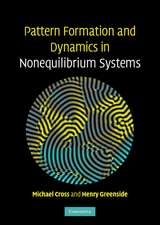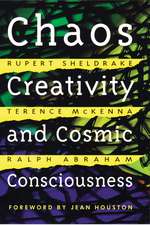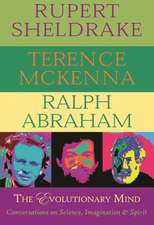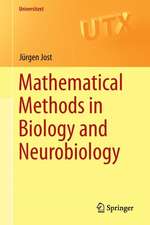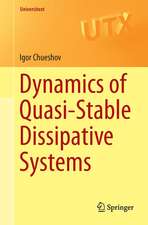Chaos in Discrete Dynamical Systems: A Visual Introduction in 2 Dimensions
Autor Ralph Abraham, Laura Gardini, Christian Miraen Limba Engleză Paperback – 18 apr 2013
Preț: 389.70 lei
Nou
Puncte Express: 585
Preț estimativ în valută:
74.57€ • 77.86$ • 61.72£
74.57€ • 77.86$ • 61.72£
Carte tipărită la comandă
Livrare economică 04-18 aprilie
Preluare comenzi: 021 569.72.76
Specificații
ISBN-13: 9781461273479
ISBN-10: 1461273471
Pagini: 280
Ilustrații: XXV, 246 p.
Dimensiuni: 170 x 244 x 15 mm
Greutate: 0.45 kg
Ediția:Softcover reprint of the original 1st ed. 1997
Editura: Springer
Colecția Springer
Locul publicării:New York, NY, United States
ISBN-10: 1461273471
Pagini: 280
Ilustrații: XXV, 246 p.
Dimensiuni: 170 x 244 x 15 mm
Greutate: 0.45 kg
Ediția:Softcover reprint of the original 1st ed. 1997
Editura: Springer
Colecția Springer
Locul publicării:New York, NY, United States
Public țintă
ResearchDescriere
Chaos Theory is a synonym for dynamical systems theory, a branch of mathematics. Dynamical systems come in three flavors: flows (continuous dynamical systems), cascades (discrete, reversible, dynamical systems), and semi-cascades (discrete, irreversible, dynamical systems). Flows and semi-cascades are the classical systems iuntroduced by Poincare a centry ago, and are the subject of the extensively illustrated book: "Dynamics: The Geometry of Behavior," Addison-Wesley 1992 authored by Ralph Abraham and Shaw. Semi- cascades, also know as iterated function systems, are a recent innovation, and have been well-studied only in one dimension (the simplest case) since about 1950. The two-dimensional case is the current frontier of research. And from the computer graphcis of the leading researcher come astonishing views of the new landscape, such as the Julia and Mandelbrot sets in the beautiful books by Heinz-Otto Peigen and his co-workers. Now, the new theory of critical curves developed by Mira and his students and Toulouse provide a unique opportunity to explain the basic concepts of the theory of chaos and bifurcations for discete dynamical systems in two-dimensions. The materials in the book and on the accompanying disc are not solely developed only with the researcher and professional in mind, but also with consideration for the student. The book is replete with some 100 computer graphics to illustrate the material, and the CD-ROM contains full-color animations that are tied directly into the subject matter of the book, itself. In addition, much of this material has also been class-tested by the authors. The cross-platform CD also contains a software program called ENDO, which enables users to create their own 2-D imagery with X-Windows. Maple scripts are provided which give the reader the option of working directly with the code from which the graphcs in the book were
Cuprins
of the Book.- 1 Introduction.- 2 Basic concepts in 1D.- 3 Basic concepts in 2D.- 4 Absorbing Areas.- 5 Holes.- 6 Fractal Boundaries.- 7 Chaotic Contact Bifurcations.- 8 Conclusion.- Appendix 1 Notations.- A1.1 Formal logic.- A1.2 Set theory.- A1.3 Point set topology.- Appendix 2 Topological Dynamics.- A2.1 Trajectories and orbits.- A2.2 Inverse images.- A2.3 Fixed points.- A2.4 Periodic trajectories.- A2.5 Limit points.- A2.6 Stable sets, attractors, and basins.- A2.7 Unstable sets and repellors.- A2.8 Chaotic attractors.- Appendix 3 Critical Curves.- A3.1 The zones.- A3.2 Critical points via calculus.- A3.3 Critical points via topology.- A3.4 The critical curves.- A3.5 Absorbing areas.- Appendix 4 Synonyms.- Appendix 5 History, Part 1.- A5.1 Early history.- A5.2 Finite difference equations.- A5.3 Functional equations.- A5.4 Poincaré.- A5.5 Independent contemporaries of Poincaré.- A5.6 Birkhoff.- A5.7 Denjoy.- A5.8 The Russian school.- A5.9 The Japanese school.- A5.10 Conservative systems.- A5.11 The American school.- A5.12 Numerical methods and applied work.- A5.13 Iteration theory.- A5.14 The methods of Liapunov.- A5.15 Periodic solutions.- A5.16 Control theory.- A5.17 Other applications.- A5.18 Conclusion.- A5.19 Historical Bibliography.- Appendix 6 History, Part 2.- A6.1 Introduction.- A6.2 G.D. Birkhoff.- A6.3 Nonlinear oscillations from 1925.- A6.4 The Mandelstham-Andronov school.- A6.5 The Bogoliubov (or Kiev) school.- A6.6 Poincaré’s analyticity theorem.- A6.7 Myrberg’s contribution.- A6.8 Conclusion.- Appendix 7 Domains of the Figures.- Frequently used references by code.- Bibliography by author.




